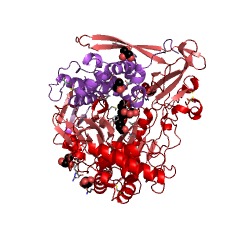| Synonyms |
AAC, acyl-homoserine lactone acylase, acyl-HSL acylase, AHL acylase, AHL amidase, AHL-acylase, AhlM, AIBP, AiiC, AiiD, AiiO, AmiE, AtPVA, auto-inducer inhibitor from Cyanobacteria, HacA, HacB, KcPGA, long-chain AHL acylase, More, N-acyl-homoserine lactone acylase, N-acylhomoserine lactone acylase, N-acylhomoserine lactone-acylase, PA0305, PA2385, PA2385 protein, PaPVA, PvdQ, PvdQ acylase, QqaR, QuiP, quorum quenching acylhomoserine lactone acylase, quorum-quenching AHL acylase, quorum-quenching enzyme, quorum-quenching N-acyl homoserine lactone acylase PvdQ, SlPVA |
| Comments |
Acyl-homoserine lactones (AHLs) are produced by a number of bacterial species and are used by them to regulate the expression of virulence genes in a process known as quorum-sensing. Each bacterial cell has a basal level of AHL and, once the population density reaches a critical level, it triggers AHL-signalling which, in turn, initiates the expression of particular virulence genes. Plants or animals capable of degrading AHLs would have a therapeutic advantage in avoiding bacterial infection as they could prevent AHL-signalling and the expression of virulence genes in quorum-sensing bacteria. This quorum-quenching enzyme removes the fatty-acid side chain from the homoserine lactone ring of AHL-dependent quorum-sensing signal molecules. It has broad specificity for AHLs with side changes ranging in length from 11 to 14 carbons. Substituents at the 3′-position, as found in?N-(3-oxododecanoyl)-L-homoserine lactone, do not affect this activity. |


